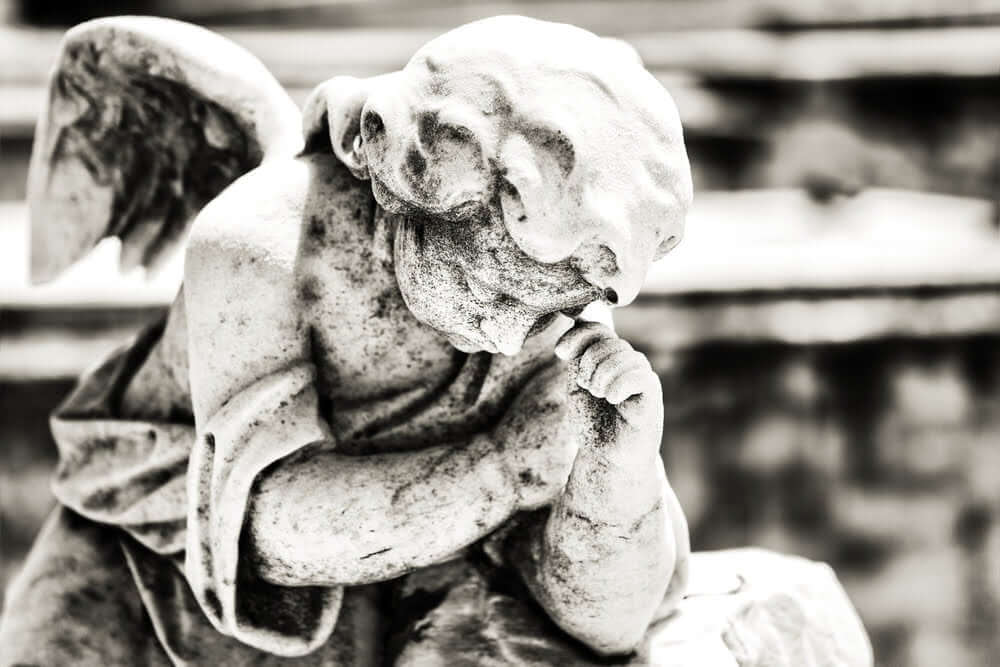Cremation versus burial? I have a tough time making this decision myself. While cremation is far more affordable, environmentally conscious, and less taxing on grieving family members, I can’t deny that I have a gut preference for being buried and allowing my loved ones to have a dedicated, tangible location to remember me.
In most cases, the “cremation or burial?” decision is complex and emotional and one that can trigger significant family tension.
So we created this guide to help you better understand each option and pinpoint exactly why you prefer one.
We’ll end by discussing why this decision is a luxury most Americans do not have and what they can do about it.
Let’s dive in.
Choose kindness.
You never know what battles people may be fighting.
A Funeral And Burial: The All-American Option
Knowing the ins and outs of each process is critical for the family member making the cremation vs. burial decision.
So we’ll begin by describing precisely what a “traditional burial” entails.
The Four Parts Of A Traditional Burial
The first part is the pre-planning portion, which will look similar for burial and cremation. This process usually begins with choosing a funeral home and meeting with its funeral director to discuss the options of final arrangements (cremation vs. burial).
If you choose a traditional funeral service, you will also have to discuss your casket, memorial service, burial vault, and other options. You will also have to arrange things like transport and embalming. Finally, you will need to consider whether a traditional funeral is affordable for you and potentially look beyond the funeral home for ways to save money (e.g., opting for casket rental or purchasing items online).
Part two involves preparing the body, including embalming and choosing how to dress and adorn your loved one for their final rest — for example, dressing them in clothing that reflects their personality and potentially choosing mementos to place within their casket.
Once done, the body is placed in a casket (also known as a coffin) and ready to be viewed.
The third part is the memorial service (also known as the “wake” or the “viewing”). Here, friends and family gather to pay their respects to the deceased and support each other in their grief.
The service is typically held at a church or funeral home. In either case, it can be a religious or non-religious affair. The image below shows you what this can look like for Catholics, whose service is typically a funeral mass held at the Catholic Church they attend.
![Cremation vs Burial: Pros and Cons [No-BS Guide] 1 Religious Funeral Service (Catholic Funeral Mass)](https://getsure.org/wp-content/uploads/Catholic-Funeral-Mass.jpg)
The service will either be “open casket” or “closed casket,” reflecting whether mourners can see the body during the service. This is a deeply personal decision and can also depend on the body’s condition.
After the funeral service, pallbearers carry the casket to the hearse, transporting the body to the cemetery. Mourners traditionally follow behind the hearse, on foot or by car, holding flowers or other mementos.
![Cremation vs Burial: Pros and Cons [No-BS Guide] 2 Family mourning in cemetery during burial](https://getsure.org/wp-content/uploads/Family-Mourning-In-Cemetery-During-Burial.jpg)
The final step is the burial itself, where family members gather to watch their loved one be laid to rest. At the gravesite, there is often another short service, during which a priest (or non-religious ceremonial leader) leads the group in prayer and bidding farewell to the deceased. In the end, your loved one is lowered into the ground and will have arrived at their final resting place.
Traditional Burial Pros & Cons
Having understood what the traditional burial and funeral service entails, let’s now go through what leads people to choose or decide against burial, starting with the pros:
Pros of Traditional Burial
- Tradition & Closure: The combination of a memorial service followed by burial is the traditional method in the U.S. Its familiarity may bring comfort to you and fellow mourners
- Physical Togetherness: Burial gives loved ones a place to visit on important dates and anniversaries and can provide a stronger sense of physical togetherness than cremated remains can. If you have a family burial plot, burial also means continuing a family tradition.
- Green Burials: Biodegradable caskets and other trends in “green burial” have made burial more environmentally friendly than in the past
Burial Cons
- Funeral Costs > $10K: Average funeral costs in many states are close to $10,000 and significantly exceed the cost of cremation services; even the most basic burial and basic service will cost you upwards of $4,000, given the costs of the cemetery plot alone
- Worse for the Environment vs. Cremation: Burial is less environmentally friendly when compared to cremation
- Burial Plot Availability: Especially if you live in an urban area, burial space may be limited, increasing either the cost of a burial plot or the distance of the gravesite from your home (making it more difficult to visit)
Check Out: Pricing guide for headstones
Choose kindness.
You never know what battles people may be fighting.
The Cremation Process
Cremation is the new kid on the block, and the details of the cremation process are still a mystery to many people.
Cremation is the process of reducing a dead body to small bone fragments (that resemble ash) by exposing it to flames and intense heat. The word comes from the Latin “cremare,” meaning “to burn until only ashes remain.”
Cremation symbolizes many things, such as reincarnation, purification from sin, freedom from worldly desires, and in Eastern religions (namely, Hinduism and Buddhism), reaching Nirvana.
Cremation also ensures that one’s remains do not pollute the Earth after passing.
![Cremation vs Burial: Pros and Cons [No-BS Guide] 3 Cremation urn and white roses](https://getsure.org/wp-content/uploads/White-Roses-By-Urn.jpg)
What Is Direct Cremation?
Most cremations are what the funeral industry calls “direct cremation.”
A direct cremation is the most basic service, with a correspondingly low price tag. It does not involve transporting the body in a hearse or limousine and uses a simple coffin. (Make sure your local funeral home offers cremation services, as some funeral homes do not.)
With this manner of cremation, there is no ceremony. It takes place without the presence of extended family and friends. Therefore, choosing cremation may make it more difficult for extended family and friends to receive the closure they typically receive from a group service.
Your Options For Handling Cremated Remains
There are a variety of ways that people handle their family member’s ashes. Here are four of the most common:
- Storing the ashes. The most common choice is to store the ashes in a cremation urn. This allows you to keep your loved one somewhere personally meaningful (often within the home) instead of a communal cemetery.
- Scattering the ashes. This option is the preferred method in India, where cremation originated.
- Burying the ashes. Catholics who are cremated often have their cremated remains buried, as the Catholic Church recommends.
- Cremation jewelry. While this may seem revolting to some, a recent trend has been to store the ashes within wearable jewelry.
Cremation Pros & Cons
Now let’s go through the pros and cons of cremation. First, the pros:
Cremation Pros
- Logistical Ease: Cremation is logistically easier, as it does not require embalming the body, arranging transport, or making as many added decisions and purchases (e.g., securing a burial plot or deciding on a burial vault and casket)
- Ashes Can Be Kept Close: Cremated remains can be kept close, even if you move, providing added comfort to many people. You can do so with a cremation urn kept at home or even by storing the ashes in jewelry you can wear
- Much Cheaper: Cremation can be significantly cheaper than burial. With burial costs having risen fast for decades, cremation is now the more financially responsible option for many
Cons of Cremation
- Crematory Availability: Cremation is still new in the U.S. Therefore, some funeral homes do not offer cremation services, and some cemeteries do not permit burying ashes (as the Catholic Church recommends for Catholics who are cremated)
- May Not Bring Closure: Cremation is typically not paired with a ceremonial service, which may inhibit closure and healing for extended family and friends who hoped to pay their respects and make final wishes to the deceased
- Lack of Physical Togetherness: Cremated remains may not give you the same feeling of physical togetherness that a cemetery plot and monument would
Conclusion & Key Takeaways
Cremation or a more traditional funeral for your loved one’s final arrangements? It’s rarely an easy decision.
Depending on your religious and personal beliefs, the two options can have vastly different appeals and emotional consequences for you and your family.
This can be especially hard on families who strongly prefer a traditional burial but cannot afford the high burial costs we see in 2021.
Sadly, they then have to weigh their desired method for honoring the deceased against the financial responsibility of that choice.
![Cremation vs Burial: Pros and Cons [No-BS Guide] 4 Buying Burial Insurance Online Is Easy](https://getsure.org/wp-content/uploads/Burial-Insurance-On-Computer.jpg)
Two Keys To Protecting Your Family And Your Legacy
Beyond the choice at hand here, two things seem clear. First, pre-planning your funeral or cremation can be one of the kindest things you do for your family while they are in the midst of one of the most challenging times in their lives (mourning your loss).
At a minimum, this should include your wish to be cremated versus buried and a plan for financing your chosen arrangement.
Second, given the emotional consequences of this choice on your family and friends, money should not decide how you are remembered, if possible.
Check out our guide to burial insurance to learn how you can save your family significant heartache in the future.
If you have any additional questions, don’t hesitate to comment or email us at [email protected]. We’ll respond within 24 hours.
Warms Regards,
The GetSure Team


